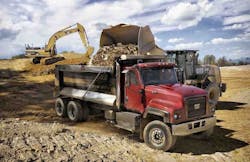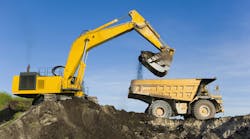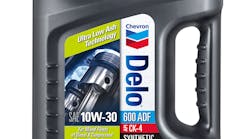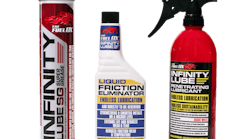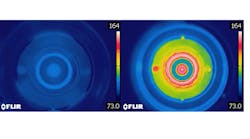The EPA (Environmental Protection Agency) and the NHTSA (National Highway Traffic Safety Administration) have had regulations in place since 2011 that address green-house-gas emissions (principally CO2) and fuel economy for medium- and heavy-duty on-highway diesels. Specific regulations are based on vehicle configuration, but the logic is simple: Vehicles that get better mileage burn less fuel and emit a lesser volume of objectionable gases.
Vehicle and engine manufacturers have made significant strides toward attaining higher levels of fuel efficiency, while simultaneously reducing particulate matter (PM) and oxides of nitrogen (NOx) in the diesel’s exhaust to miniscule levels. The prospect of the EPA/NHTSA regulations becoming more stringent in 2017, however, has engine and vehicle manufacturers—and oil companies, as it turns out—developing even more advanced technology to improve fuel economy.
To learn more about PC-11, visit the Shell Rotella “What Is PC-11” website
For some vehicle configurations, says Len Badal, commercial sector manager for Chevron, the new regulations could mean fuel-economy improvements on the order of 20 percent. The industry, he says, is looking at every means to reduce friction in the engine and to minimize parasitic power drains on the engine, the latter, perhaps, facilitated by recovering energy presently lost as heat and using it to drive small turbines that could power the vehicle’s electrical components.
When these more stringent requirements were first discussed, says Dan Arcy, OEM technical manager, Shell Global Solutions, engine and vehicle manufacturers from both the on-highway and off-highway sectors approached the API (American Petroleum Institute) and suggested that a new class of heavy-duty engine oil might be required. The group based its reasoning on several concerns, says Arcy, including performance issues with some formulations of the current heavy-duty oil (CJ-4), possible changes in engine design and engine operating conditions that might place even greater demands on engine oil, and the need to further improve fuel economy.
(CJ-4, presently used in both on- and off-highway heavy-duty applications, was released in 2006 and formulated for engines meeting the EPA’s 2007 emissions regulations for on-highway diesels.)
Room for improvement
Among specific concerns about CJ-4 performance, says Arcy, were questions about the oil’s ability to handle the expected higher operating temperatures of future engines in terms of adequately controlling oxidation, a primary cause of oil breakdown that is accelerated by higher operating temperatures.
Some in the industry speculate that increased operating temperatures might result in part from future engines relying less on EGR (exhaust-gas recirculation)—and more on selective catalytic reduction (SCR)—to control NOx emissions. Since EGR works by lowering combustion temperatures to retard NOx formation in the cylinders, some engine designers say that reducing the volume of EGR (or eliminating the system in some applications) allows the engine to run hotter for more efficient combustion and, subsequently, better fuel economy.
Also on the list of concerns were aeration control (the oil’s ability to release entrained air caused by churning engine parts) and shear-stability (the ability of viscosity-stabilizing polymers in the oil to resist being mechanically broken apart between moving engine components). Shearing results in lowered viscosity, a condition unacceptable if the oil can no longer maintain an adequate protective film between such parts as engine bearings and crankshaft journals.
“The concern was that some CJ-4 oils in the market were shearing out of grade,” says Arcy, “or at least shearing down more than engine manufacturers would like to see.”
Another concern was that some of the nearly 20 tests required to evaluate CJ-4 performance would not be stringent enough to determine a new oil’s performance in the working environments anticipated for future engines, specifically tests for oxidation control, shear stability, cylinder-liner scuffing, and aeration control.
API formed a New-Category Evaluation Team to investigate the concerns voiced and to evaluate the need for moving beyond CJ-4. The consensus, says Arcy, was that the development of a new heavy-duty engine oil was well-advised, and oil companies presently are moving forward with new formulations of base stocks and additive packages that will address the issues raised. Also, added or revised tests will impose more stringent performance standards for oxidation control, shear-stability, and aeration control.
PC-11—not once, but twice
Actually, development of the new oil, identified temporarily as PC-11 (PC for “Proposed Category”), is taking two paths: PC-11A and PC-11B, both of which have a licensing date (commercial availability) of December 1, 2016. When the new oils reach the market, PC-11A likely will be identified as API CK-4 and PC-11B as API FA-4.
PC-11A is a direct replacement for CJ-4. It’s backward compatible, meaning it can be used in any engine that uses CJ-4, and it will be available in the entire spectrum of grades available today, as well as in conventional, synthetic, and synthetic-blend formulations as appropriate. PC-11A also is suitable for use in future engines; that being true, why the need for PC-11B?
The answer is fuel economy. PC-11B will be formulated to exhibit all the advances in oxidation control, shear-stability, and aeration control as PC-11A, but it will have significantly lower viscosity—“viscosity” being defined as “the extent to which a fluid resists the tendency to flow.” PC-11B will be available only as “x”W-30 grades, that is, 0W-30, 5W-30, and 10W-30, but will be available in conventional, synthetic, and synthetic-blend configurations as appropriate to specific formulation.
Chevron’s Badal likens the viscosity differences between PC-11A and PC-11B to attempting to run in a swimming pool with water up to your waist, compared with running in a pool with water just to your knees. An engine using oil of lesser viscosity gets better fuel economy, he says, because it’s not working as hard to move components through the fluid. Fluid-frictional losses are reduced, because the oil film between components is not as thick; the critical consideration, though, says Badal, is to ensure that the engine running with a thinner oil film is adequately protected against wear.
PC-11B’s lower viscosity will likely limit its backward compatibility; some experts, in fact, say that it can’t be used in older engines, but the jury seems still to be out on the question. Each engine manufacturer, it seems, will have to determine if—or in what older models—PC-11B formulations will be acceptable.
One engine manufacturer has stated that the company is “developing engine designs specifically for the new low-viscosity oils, as well as [working toward] understanding the effects of low-viscosity oils in its older engines. [The company] is working to make sure these oils will maintain durability in both current and new engines and is committed to maintaining compatibility with both subcategories.”
Fundamental questions
All this said, two questions come to mind: If you arbitrarily choose an oil grade available in both a PC-11A and PC-11B formulation—for example, 10W-30—how can the latter, having the same grade rating, be of lesser viscosity than the former and thus yield better fuel economy? And—how do xW-30 PC-11B formulations differ from some of the more recently released xW-30 CJ-4 formulations that oil companies advertise as a means for increasing fuel economy with no compromise in protection?
In regard to the latter question, claims for fuel-economy improvements from these newer CJ-4 oils range from around 1 to 4 percent, the higher estimates predicated on also using lower-viscosity lubricants in drive-train components. In most instances, the advertised improvements result from comparing fuel economy using a new 30-weight oil—perhaps having a reformulated additive package to afford increased wear protection—with fuel economy when using a typical 15W-40 formulation, long the standard for heavy-duty engines.
According the Shell’s Arcy, 15W-40 has lost ground to 10W-30 in the past couple of years. Most heavy-duty highway trucks leave the factory with a fill of 10W-30, he says, or at least offer the customer the option of the lighter oil. He says, also, that large fleets have started shifting to 10W-30 (versus 15W-40) in the interest of better fuel economy.
Measuring viscosity
All of which leads back to the question about PC-11B’s lower viscosities, compared with comparable grades of PC-11A. Arcy and Badal explain that oil viscosity is measured with two required tests: a “kinematic” viscosity test and a “high-temperature/high-shear” (HTHS) viscosity test.
“The viscosity stated on the oil can is an SAE [Society of Mechanical Engineers] designation determined by the kinematic process,” says Arcy. “The test is conducted in a low-shear environment at 100C, and it’s basically a measure of how fast oil flows through a tube by gravity—moved along by its own weight—and the result is expressed in ‘centistokes.’ Viscosity might be stated as 10W-30, but the designation is actually a range, which for an SAE 30-weight varies from around 9.3 to 12.5 centistokes.”
Current CJ-4 30-weight formulations, as will future PC-11A formulations, says Arcy, have viscosities near the 12.0- to 12.5-end of the centistoke (cSt) scale. PC-11B formulations will be blended down around the 9.3-cSt end of the scale, “close to a 20-weight,” he says, where fuel-economy benefits are significant. A CJ-4 15W-40 oil, by comparison, has a typical cSt value of 14.5-15.0.
The HTHS viscosity test—which measures viscosity in a high-pressure, high-shear environment at 150C and has a rating scale calibrated in “centipoise” (Cp) units—looks at the film thickness of oil in such critical areas as bearings and rings, says Arcy. A typical CJ-4 15W-40 oil might have a Cp rating between 3.9 and 4.2, and a newer 10W-30 CJ-4 formulation advertised as having a beneficial effect on fuel economy might have a rating of 3.5-3.6 Cp—about the same as that anticipated for PC-11A formulations.
By comparison, PC-11B oils will be blended with Cp ratings between 2.9 and 3.2, which give them a “low” HTHS designation, compared with PC-11A’s “high” HTHS designation. Given the viscosities of “low” HTHS PC-11B oils, says Badal, “you must have a very shear-stable product to keep it in grade—because if it goes any lower, you might have wear in bearings or the valve train. PC-11B might have a slightly different additive package than PC-11A to give it more wear protection and to make it more shear-stable, but it’s not expected to be much more expensive.”
Arcy adds that beyond engine-protection concerns when using PC-11B are also concerns about the effect thinner oil might have on systems in older engines. For example, would an oil-pressure sender need recalibrating to keep from displaying a low-pressure fault on the dash? Would hydraulically actuated systems that use engine oil function as well with thinner oil?
Badal also raises questions surely to be voiced: What if I get new trucks filled with PC-11B, but I have older trucks that can’t take the new oil? Do I run two oils? In this situation, says Badal, the truck owner could standardize with a PC-11A 10W-30 or 15W-40, with the only compromise being some degree of fuel-economy loss.
Situations involving equipment fleets having a mix of old and new trucks and a mix of old and new construction machines could be handled in a similar fashion, says Badal.
“None of the off-road people want PC-11B in their machines,” says Badal, “because engine durability is more important than fuel economy. Our recommendation for such mixed fleets is to use PC-11A in a grade sanctioned by the manufacturer in order to consolidate to one product and to ensure engine protection. If I were an off-highway-equipment user, I’d look at the PC-11A formulations as providing increased oxidative stability and improved wear control, versus API CJ-4 oils. This may lead to the ability to extend oil-drain intervals, which would be a big plus—while maintaining equipment durability.”
